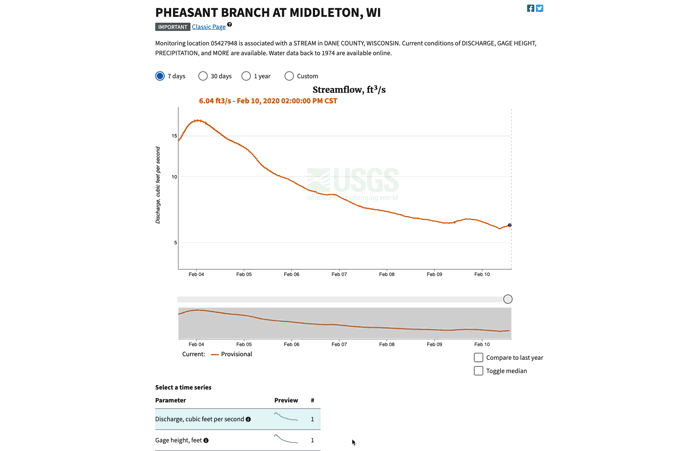Release Notes for February 28th, 2020
A summary of new features and tools released on or before February 28, 2020
The last several months have been exciting. We have been able to complete work related to:
Cloud migration of the Water Quality Portal
Cloud migration of the Network Linked Data Index (NLDI)
Brush and zoom capability for hydrographs
On January 16, 2020 the Water Quality Portal was deployed to the cloud!
One of the most notable releases since the last set of release notes is one that our users barely noticed. One of the products of the Water Data for the Nation Team is the Water Quality Portal , a cooperative project between the U.S. Geological Survey and the Environmental Protection Agency that makes discrete water quality data available in a single, standards-driven way. The Water Quality Portal has grown from a proof of concept pilot project to a tool that organizations depend on, and from making 150 million rows of data available to nearly 400 million rows of data from over 400 partner agencies. As the application grew, it became clear that its existing hosting solutions in an on-premise data system were not going to be able to scale to meet the needs of its users. On January 16th, with only a few small hiccups, the Water Quality Portal was transitioned to a cloud-hosted tool with a postgres backing store.
Moving the WQP was not an insignificant effort. Rather than attempt a “lift and shift” based approach, we did our best to turn the Water Quality Portal into a cloud-native application. In its on-premise version, the WQP runs on five virtual machines, backed by a 16-core beast of a database. In the cloud version, the applications are all containerized, running in in a cluster of “containers as a service,” backed by a postgres database running in a database as a service. The lessons learned in this migration have been applied to everything else that we have been doing as we build new services for Water Data for the Nation. Good news for users- the uptime history looks great since the transition! See Figure 1 for more details.
Interested in the technical details? Find the development trail here at our open-source code repository here: https://github.com/NWQMC .

Screenshot showing 100% uptime (green dots) for the Water Quality Portal in the days following the January 16th transition to the cloud. The status dashboard gives the latest view of WQP uptime.
Cloud migration of the Hydro Network Linked Data Index
The Hydro Network Linked Data Index has finally been publicly deployed to the cloud. NLDI gives users the ability to query upstream and downstream on the monitoring location pages. Similar to the Water Quality Portal, NLDI was transformed from an on-premise application into a cloud native application.

Map showing the gages 200 miles upstream and downstream on the main stream of the Colorado River from monitoring location 09380000, Colorado River at Lee’s Ferry, AZ
Brush and zoom capability for hydrographs
The new brush and zoom capability allows the user to easily select any part of the hydrograph for closer examination. The user simply selects a desired timeframe on the lower hydrograph which is then reflected in the upper hydrograph.

Hydrograph animation showing a select sub-range (in gray) of streamflow for monitoring location 05427948, Pheasant Branch at Middleton, WI .
Other new features and tools
- Implementation of the OGCAPI-Features standard (stay tuned for a blog post on this subject)
- Repositories page: https://labs.waterdata.usgs.gov/repositories/
- Collapsible legend on NLDI maps within monitoring location pages
What is coming up for next sprint
- Add handles to brush on the monitoring location page hydrograph
- Bookmarkable state on monitoring location pages
- Continued work on a Groundwater Daily Value graph
- Back-end data delivery enhancements
Disclaimer
Any use of trade, firm, or product names is for descriptive purposes only and does not imply endorsement by the U.S. Government.
Categories:
Keywords:
Related Posts
Release Notes for July 21st, 2020
July 21, 2020
What have we been up to? Pubs Warehouse moved to the Cloud Behind the scenes work New features and tools Pubs Warehouse on the Cloud The Water Data for the Nation team is the primary development team for another high profile application, the USGS Publications Warehouse .
Release Notes for late March 2020
April 10, 2020
What have we been up to? Image server work Period parameter Axis scaling Networks page New features and tools Image export from monitoring location pages One of the most requested features we receive from users is the ability to export images from the monitoring location pages.
Release Notes for late February and early March 2020
March 20, 2020
What have we been up to? Added handles to brush on the monitoring location page hydrograph State of hydrograph saved for bookmarking/linking Display upstream basin from NLDI for each monitoring location A number of additional graph server parameters New data services for monitoring locations Brush handles added to monitoring location page hydrograph Based on user feedback, the team upgraded the brush and zoom capability on the hydrograph by adding handles, making it more apparent that the zoom functionality is available and making it easier to use.
Release Notes for November 13, 2019
November 13, 2019
What have we been up to? This sprint, we have been working on a number of features that are the groundwork for future tools. Most notably, we are developing a working monitoring location services system based on the new Open Geospatial Consortium OGC API-Features standard .
Release Notes for October 16, 2019
October 16, 2019
What have we been up to? This sprint, the team has been working primarily on features that are tied to the cloud version of the USGS Publications Warehouse .

